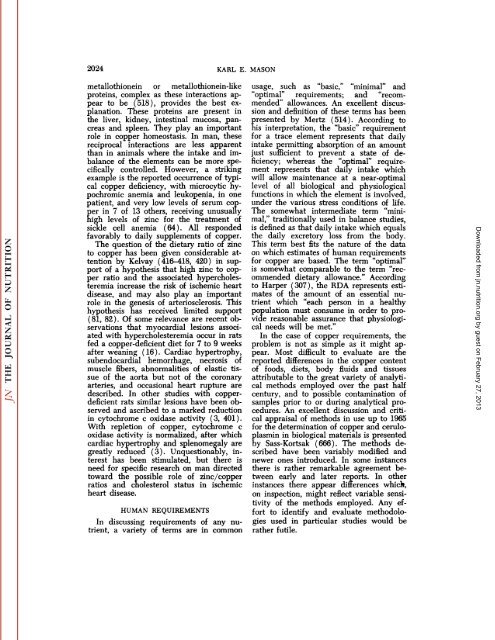conspectus of researchon copper metabolism and requirements
conspectus of researchon copper metabolism and requirements
conspectus of researchon copper metabolism and requirements
You also want an ePaper? Increase the reach of your titles
YUMPU automatically turns print PDFs into web optimized ePapers that Google loves.
2024 KARL E. MASON<br />
metallothionein or metallothionein-like<br />
proteins, complex as these interactions ap<br />
pear to be (518), provides the best ex<br />
planation. These proteins are present in<br />
the liver, kidney, intestinal mucosa, pan<br />
creas <strong>and</strong> spleen. They play an important<br />
role in <strong>copper</strong> homeostasis. In man, these<br />
reciprocal interactions are less apparent<br />
than in animals where the intake <strong>and</strong> im<br />
balance <strong>of</strong> the elements can be more spe<br />
cifically controlled. However, a striking<br />
example is the reported occurrence <strong>of</strong> typi<br />
cal <strong>copper</strong> deficiency, with microcytic hypochromic<br />
anemia <strong>and</strong> leukopenia, in one<br />
patient, <strong>and</strong> very low levels <strong>of</strong> serum cop<br />
per in 7 <strong>of</strong> 13 others, receiving unusually<br />
high levels <strong>of</strong> zinc for the treatment <strong>of</strong><br />
sickle cell anemia (64). All responded<br />
favorably to daily supplements <strong>of</strong> <strong>copper</strong>.<br />
The question <strong>of</strong> the dietary ratio <strong>of</strong> zinc<br />
to <strong>copper</strong> has been given considerable at<br />
tention by Kelvay (416-418, 420) in sup<br />
port <strong>of</strong> a hypothesis that high zinc to cop<br />
per ratio <strong>and</strong> the associated hypercholesteremia<br />
increase the risk <strong>of</strong> ischemie heart<br />
disease, <strong>and</strong> may also play an important<br />
role in the genesis <strong>of</strong> arteriosclerosis. This<br />
hypothesis has received limited support<br />
(81, 82). Of some relevance are recent ob<br />
servations that myocardial lesions associ<br />
ated with hypercholesteremia occur in rats<br />
fed a <strong>copper</strong>-deficient diet for 7 to 9 weeks<br />
after weaning (16). Cardiac hypertrophy,<br />
subendocardial hemorrhage, necrosis <strong>of</strong><br />
muscle fibers, abnormalities <strong>of</strong> elastic tis<br />
sue <strong>of</strong> the aorta but not <strong>of</strong> the coronary<br />
arteries, <strong>and</strong> occasional heart rupture are<br />
described. In other studies with <strong>copper</strong>deficient<br />
rats similar lesions have been ob<br />
served <strong>and</strong> ascribed to a marked reduction<br />
in cytochrome c oxidase activity (3, 401).<br />
With repletion <strong>of</strong> <strong>copper</strong>, cytochrome c<br />
oxidase activity is normalized, after which<br />
cardiac hypertrophy <strong>and</strong> splenomegaly are<br />
greatly reduced (3). Unquestionably, in<br />
terest has been stimulated, but there is<br />
need for specific research on man directed<br />
toward the possible role <strong>of</strong> zinc/<strong>copper</strong><br />
ratios <strong>and</strong> cholesterol status in ischemie<br />
heart disease.<br />
HUMAN REQUIREMENTS<br />
In discussing <strong>requirements</strong> <strong>of</strong> any nu<br />
trient, a variety <strong>of</strong> terms are in common<br />
usage, such as "basic," "minimal" <strong>and</strong><br />
"optimal" <strong>requirements</strong>; <strong>and</strong> "recom<br />
mended" allowances. An excellent discus<br />
sion <strong>and</strong> definition <strong>of</strong> these terms has been<br />
presented by Mertz (514). According to<br />
his interpretation, the "basic" requirement<br />
for a trace element represents that daily<br />
intake permitting absorption <strong>of</strong> an amount<br />
just sufficient to prevent a state <strong>of</strong> de<br />
ficiency; whereas the "optimal" require<br />
ment represents that daily intake which<br />
will allow maintenance at a near-optimal<br />
level <strong>of</strong> all biological <strong>and</strong> physiological<br />
functions in which the element is involved,<br />
under the various stress conditions <strong>of</strong> life.<br />
The somewhat intermediate term "mini<br />
mal," traditionally used in balance studies,<br />
is defined as that daily intake which equals<br />
the daily excretory loss from the body.<br />
This term best fits the nature <strong>of</strong> the data<br />
on which estimates <strong>of</strong> human <strong>requirements</strong><br />
for <strong>copper</strong> are based. The term "optimal"<br />
is somewhat comparable to the term "rec<br />
ommended dietary allowance." According<br />
to Harper (307), the RDA represents esti<br />
mates <strong>of</strong> the amount <strong>of</strong> an essential nu<br />
trient which "each person in a healthy<br />
population must consume in order to pro<br />
vide reasonable assurance that physiologi<br />
cal needs will be met."<br />
In the case <strong>of</strong> <strong>copper</strong> <strong>requirements</strong>, the<br />
problem is not as simple as it might ap<br />
pear. Most difficult to evaluate are the<br />
reported differences in the <strong>copper</strong> content<br />
<strong>of</strong> foods, diets, body fluids <strong>and</strong> tissues<br />
attributable to the great variety <strong>of</strong> analyti<br />
cal methods employed over the past half<br />
century, <strong>and</strong> to possible contamination <strong>of</strong><br />
samples prior to or during analytical pro<br />
cedures. An excellent discussion <strong>and</strong> criti<br />
cal appraisal <strong>of</strong> methods in use up to 1965<br />
for the determination <strong>of</strong> <strong>copper</strong> <strong>and</strong> ceruloplasmin<br />
in biological materials is presented<br />
by Sass-Kortsak (666). The methods de<br />
scribed have been variably modified <strong>and</strong><br />
newer ones introduced. In some instances<br />
there is rather remarkable agreement be<br />
tween early <strong>and</strong> later reports. In other<br />
instances there appear differences which,<br />
on inspection, might reflect variable sensi<br />
tivity <strong>of</strong> the methods employed. Any ef<br />
fort to identify <strong>and</strong> evaluate methodolo<br />
gies used in particular studies would be<br />
rather futile.<br />
Downloaded from<br />
jn.nutrition.org<br />
by guest on February 27, 2013
















